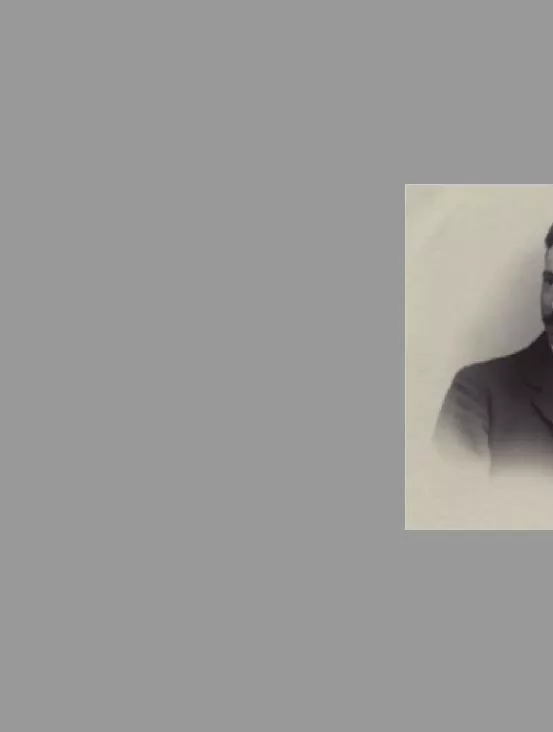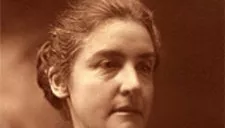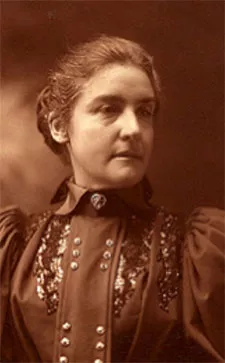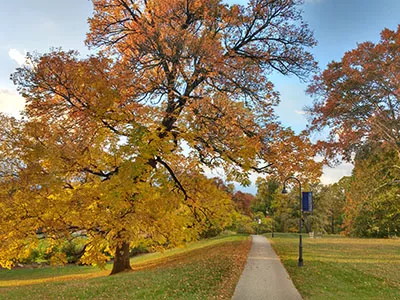
This article appeared in the Fall 2016-Spring 2017 Bryn Mawr Math Alumnae Newsletter.
The Mathematics Department of Bryn Mawr College has a rich history. Its founding chair was Charlotte Angas Scott, the first woman to earn a mathematics Ph.D. in Britain. It was home to Anna Pell Wheeler, a University of Chicago Ph.D. and one of the original trustees of the American Mathematical Society. And it welcomed the great Emmy Noether after she fled Nazi Germany in the 1930s.
Perhaps less well known is that Bertrand Russell—philosopher, mathematician, social critic, atheist, Fellow of the Royal Society, and Nobel Laureate—had strong connections to the department. Here we discuss his November 1896 visit when he gave a series of geometrical lectures on campus. This was his first appearance at any U.S. college or university.
In being invited to speak, Bertrand had a distinct advantage: his wife, Alys Pearsall Smith, was a member of the Class of 1890 and—better yet—the cousin of Bryn Mawr College President Carey Thomas. In a letter to Carey of February 1896, Alys raised the subject: "If thee really can find him [Bertrand] a few, even one or two hearers, for six lectures...he would love to give these lectures at Bryn Mawr." Although Russell became world famous in the 20th century, he was at this time still an obscure scholar, so Carey Thomas asked Professor Scott to check him out during her summer trip home to England. Scott met with Russell, discussed topics for his Bryn Mawr lectures, and endorsed an invitation with the observation that "He seems to be getting quite a reputation in Cambridge among those whose opinion is worth having."
And so, Bertrand and Alys Russell sailed to the United States in the fall of 1896. They stayed on campus for an extended period, and Bertrand gave his promised lectures to "30 people." He later crafted these into a book, An Essay on the Foundations of Geometry, that was published by Cambridge University Press in 1897...and is still in print.
The Lantern, Bryn Mawr's student newspaper, covered the story. "Mr. Russell in his first lecture," they reported, "stated that his object was to determine which of the axioms of Geometry were to be regarded as a priori, and therefore involved in any conception of space, and which were empirical, or dependent on the experience of some special form of space." The Lantern also observed that "Not the least pleasant circumstance...was the privilege of meeting Mr. Russell at the close of the hour, when questions were asked and answered in regard to any obscure or knotty point."
All of this was fine. But Russell, the great contrarian, was ever ready to rock the boat. Besides his mathematical lectures, he spoke to the Graduate Club of Bryn Mawr on the topic of socialism. Meanwhile Alys, in her own address, raised the possibility of women's forgoing motherhood for a career. These were controversial topics during what was—literally—the Victorian Era.
After the Russells left for Baltimore, President Thomas got an earful from parents who were alarmed that their daughters had been radicalized by visitors from England. "I slept well last night," Carey wrote in the midst of the uproar, "and this in spite of receiving...disgusting and disturbing letters from the mothers of two girls about Alys and Bertie." She even addressed the matter before the student body in Taylor Hall, stressing that the Russells' comments were "entirely without my knowledge and approval."
This reaction is odd because Carey Thomas was an unmarried woman who poured her energies into an academic career. "Half of what they say—indeed I fancy all of it—is exactly what we believe," Carey con fided, "but it is all the worse to have it said." As president of a college, she sought to minimize unwelcome publicity.
Then, having tamped down parental criticism, Carey got blasted by David Scull, a College trustee so conservative that he was known to remove books from the library because their contents were unfi t for young women's eyes. An irate Scull wrote to Carey about a passage he'd seen in a Philadelphia newspaper: "Only the other day, a woman came here from England and lectured before a lot of college girls saying that women should not be hampered by motherhood. Such teaching is harmful to the greatest degree." The paper did not explicitly mention Bryn Mawr, but Scull thought that people would figure it out and predicted an enrollment debacle in the coming year. Although his prediction never materialized, he made Carey Thomas's life even more miserable.
As a result of this situation—when an innocent invitation to address the Math Department somehow morphed into a firestorm of controversy—Carey Thomas never again invited Bertrand Russell to campus. Decades later, she recalled "the great agitation" that his 1896 visit had caused.
Nonetheless, Russell did return on two occasions. One was in 1914 at the private invitation of Professor Lucy Donnelly, a revered professor of English and dear friend. The second, and more extensive, visit came in 1943 - 44, after Russell's views on sex, marriage, and religion had cost him his appointment at City College of New York (CCNY). There, the judge who vacated the appointment famously concluded that Russell should not occupy a "chair of indecency" at CCNY. Russell temporarily found a position at the Barnes Foundation near Philadelphia, but this ended abruptly when he was fired by the eccentric Dr. Barnes. Although larger universities ignored his plight, Russell was given refuge at Bryn Mawr through the assistance of Paul Weiss of the Philosophy Department. With gratitude, Russell observed that the College had demonstrated "no small degree of courage" in providing a home to so controversial a scholar.
This suggests, correctly, that Bertrand Russell was a fan of Bryn Mawr. He described the students he met during his 1896 visit as superior to the women he had known at Cambridge. After that visit, Russell had given his geometrical lectures at Johns Hopkins but chose not to repeat them on other U.S. campuses because, as Alys put it, "Bertie...feels that Johns Hopkins and Bryn Mawr are the best." (Take that, Harvard!) Through his friendship with Lucy Donnelly, he met her roommate, Edith Finch of the BMC Class of 1922, who became his (fourth) wife in 1952. And, at a period when his life was especially turbulent, he wrote wistfully to Lucy that "I can still see in my mind's eye the beauty of Bryn Mawr in autumn."
So, even if Scott, Pell Wheeler, and Noether deserve top billing in the history of the BMC Math Department, Bertrand Russell is surely a distinguished member of our supporting cast.
Sources: Karen Parshall, "Training Women in Mathematical Research: The First Fifty Years of Bryn Mawr College (1885-1935)," The Mathematical Intelligencer, 37 (2015), pp. 71-83. William Dunham, "Bertrand Russell at Bryn Mawr," The Mathematical Intelligencer, 38 (2016), pp. 30-40.
— Bill Dunham is a visiting professor and research associate in the Department of Mathematics at Bryn Mawr College.


